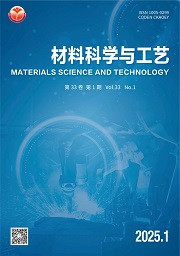| 引用本文: | 郝振源,桑言祥,吴友平.天然橡胶-氢化丁腈橡胶的共硫化及性能研究[J].材料科学与工艺,2024,32(2):20-28.DOI:10.11951/j.issn.1005-0299.20220378. |
| HAO Zhenyuan,SANG Yanxiang,WU Youping.Co-vulcanization and properties of natural rubber-hydrogenated nitrile rubber composites[J].Materials Science and Technology,2024,32(2):20-28.DOI:10.11951/j.issn.1005-0299.20220378. |
|
| 摘要: |
| 天然橡胶(NR)和氢化丁腈橡胶(HNBR)因不饱和度和极性的差异,存在硫化速度不匹配、填料分散等问题,难以实现两胶的并用。本文通过先制备不同硫黄/促进剂比例的NR和HNBR母炼胶,再将母炼胶并用制备NR/HNBR复合材料,解决了NR和HNBR共硫化的问题。研究了NR/HNBR的相态结构和填料在NR和HNBR两相的分散状态,结合相态结构和填料分散分析了NR/HNBR并用比对复合材料硫化特性、动静态力学性能、耐磨性和压缩温升的影响。结果表明:并用HNBR的复合材料混炼胶的门尼黏度增大,焦烧时间和正硫化时间缩短;随着HNBR含量增加,HNBR相的尺寸增大,硫化胶的硬度及100%和300%定伸应力增加,拉伸强度、撕裂强度、断裂伸长率和拉断永久变形减小,耐磨性和抗湿滑性提高,压缩疲劳温升增大。 |
| 关键词: 天然橡胶 氢化丁腈橡胶 共硫化 填料分散 物理性能 动态性能 耐磨性 |
| DOI:10.11951/j.issn.1005-0299.20220378 |
| 分类号:TB332 |
| 文献标识码:A |
| 基金项目: |
|
| Co-vulcanization and properties of natural rubber-hydrogenated nitrile rubber composites |
|
HAO Zhenyuan1,SANG Yanxiang1,WU Youping1,2
|
|
(1.Beijing Engineering Research Center of Advanced Elastomers, Beijing University of Chemical Technology, Beijing 100029, China;2.School of Materials Science and Engineering, Beijing University of Chemical Technology, Beijing 100029, China) [HJ1.7mm]
|
| Abstract: |
| For blends of natural rubber (NR) and hydrogenated nitrile butadiene rubber (HNBR), problems such as mismatching vulcanization speed and dispersion of fillers due to the difference in unsaturation and polarity make it difficult to prepare NR/HNBR composites. In the present study, the problem of NR and HNBR co-vulcanization was resolved by first preparing NR and HNBR master batches with different sulfur/accelerator ratios, and then combining the master batches. Then, the phase structures of NR/HNBR and filler dispersion in NR and HNBR were examined. Based on the results of phase structures and filler dispersion, the effects of NR/HNBR blending ratios on the vulcanization characteristics, dynamic and static mechanical properties, heat build-up and wear resistance of the composites were analyzed. The results show that the Mooney viscosity of compounds increases, with the scorch time and cure time of the compounds with HNBR shortened. With the increase of HNBR content, the size of HNBR phase increases; the hardness and stresses at 100% or 300% strains of vulcanizates grow; the tensile strength, tear strength, elongation at break and tensile set decrease; the wear resistance and wet skid resistance improves, and the temperature rise of compression fatigue increases. |
| Key words: natural rubber hydrogenated nitrile rubber co-vulcanization filler dispersion physical property dynamic performance abrasion resistance |






